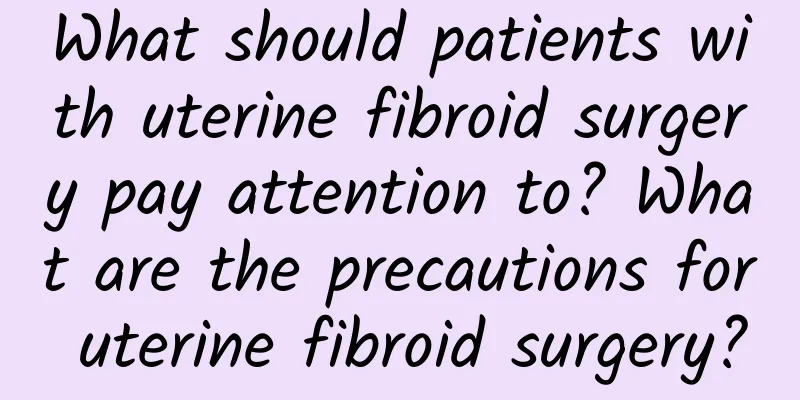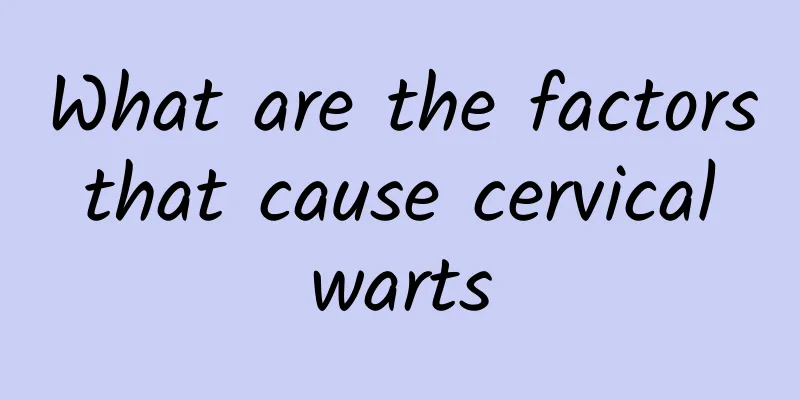What should patients with uterine fibroid surgery pay attention to? What are the precautions for uterine fibroid surgery?

|
In the past, the age for hysterectomy for patients with myoma was set at over 45 years old. Now it seems that we should proceed from reality, especially according to the progress of gynecological endocrinology. The age for ovarian preservation is generally 50 years old (the average age of menopause is 49.5 years old), that is, those who are under 50 years old should retain their ovaries if they can. Or the normal ovaries of those who have not reached menopause after 50 years old should also be retained, regardless of age. Because the normal ovaries still have certain endocrine functions after menopause and will work for 5 to 10 years. Retaining the ovaries helps stabilize the autonomic nerves, regulate metabolism, and facilitate the transition to old age. The uterus also has its endocrine function. It is the target organ of the ovaries and should not be removed casually. Usually, the age for hysterectomy is set at over 45 years old. Those under 45 years old, especially those under 40 years old, should undergo myomectomy. For those who retain the adnexa, if both sides can be retained, it is better to retain both sides than to retain only one side. The incidence of ovarian cancer in those who retain the ovaries is 0. Not higher than 15% of those who do not remove the uterus. Uterine fibroid surgery patients must read Uterine fibroid surgery 1. Myomectomy: It is a surgery to remove the fibroids on the uterus and preserve the uterus. It is mainly used for those under 45 years old, especially those under 40 years old. This is not only for infertile women who have no children, but also for those who have children, with large fibroids with a diameter greater than 6cm; menorrhagia, conservative medication is ineffective; or there are compression symptoms; submucosal fibroids; fibroids grow rapidly. Resection should also be performed for mental health. As for the number of fibroids, it is usually limited to 15. No matter how many children there are, even more than 100, there are examples of resection. In order to prevent fibroids from growing again before or after uterine fibroid surgery, you can take Qinghonggongqing tablets to prevent fibroids from growing again. In order to prevent abdominal adhesion after surgery, the incision on the uterus should be made on the anterior wall, and as few incisions as possible should be made, and as many fibroids as possible should be removed from one incision. Penetration of the endometrium should also be avoided as much as possible. The incision should be hemostatic and the incision should be sutured without leaving dead space. After the operation, the uterine incision should be peritonealized as much as possible. For submucosal fibroids that have prolapsed from the cervix, the fibroids can be removed vaginally. Avoid excessive traction during removal to avoid damaging the uterine wall. For those that have not prolapsed, they can also be removed through abdominal hysterotomy. Hemostatic drugs and antibiotics should be given for postoperative treatment; non-pregnant women should take contraceptive measures for 1 to 2 years; future pregnancies should be alert to uterine rupture and placenta implantation, and selective cesarean section should be performed at full term. There is a possibility of recurrence after myomectomy, so regular check-ups are recommended. 2. Hysterectomy: If expectant therapy and drug therapy cannot improve the patient's symptoms and the patient needs surgery but is not eligible for myomectomy, hysterectomy is recommended. Hysterectomy can be performed by total hysterectomy or vaginal hysterectomy. Hysterectomy is mainly performed by abdominal surgery. For patients with small tumors, no inflammation or adhesions in the appendages, excessive abdominal obesity, and eczema on the abdominal wall, vaginal surgery may be considered. The advantages of transabdominal surgery are: the technical operation is simpler than transvaginal surgery, less bleeding, and larger fibroids and adnexal adhesions can be handled more easily. The disadvantage is that if there is rectocele and vaginal wall relaxation, vaginal surgery is often required. Complex cases such as cervical and broad ligament myomas cause severe anatomical variations and adhesions of pelvic organs (ureters, bladder, rectum, large blood vessels, etc.), and difficult surgical exposure, which all bring great difficulties to surgery. These issues can be found in monographs on gynecological surgery. Large submucosal myomas cause bleeding and secondary severe anemia. Generally, blood transfusions are given to improve the body's condition before surgery (simple myomectomy or hysterectomy). However, in remote rural areas, there is sometimes a lack of blood supply, bleeding does not stop, and it is not suitable to move or walk. If the cervix is dilated and the myoma has protruded outside the cervix or near the vaginal opening, the myoma should be removed vaginally, which is often more helpful in stopping bleeding and correcting general conditions. Hysterectomy is generally recommended, especially for those with cervical hypertrophy, laceration or severe erosion. However, if the patient is in poor general condition and the technical conditions are limited, subtotal hysterectomy can be performed, and the incidence of stump cancer is only about 1-4%. However, regular check-ups are still recommended after surgery. Postoperative care for patients undergoing uterine fibroid surgery 1. Wound care Usually, the wound of laparoscopy is one centimeter long at the navel, and there are 0.5 cm wounds on both sides of the lower abdomen. After the operation, the one-centimeter wound is usually or simply sutured. At this time, absorbable or non-absorbable sutures can be used. If non-absorbable sutures are used, there is no need to remove the sutures after 7 days after the operation if absorbable sutures are used; as for the 0.5 cm wound, it can be taped with breathable tape, but sometimes in order to increase the neatness of wound healing, stitches and simple sutures can also be used. For the care of these wounds, care should be taken to keep the wound clean, dry, and completely healed with other wounds (about 10 days) before showering or getting wet. Most importantly, since the hospitalization days for laparoscopic patients are very short, patients must pay attention to whether the wound is red, swollen, hot, and painful every day after returning home to prevent infection and inflammation. However, inflammation of the wound after laparoscopic surgery is quite rare. 2. Vaginal bleeding During surgery, in order to make the ovaries, fallopian tubes and the back of the uterus clear or provide enough space for surgery, a uterine support device is usually placed in the vagina (not used by unmarried women) to adjust the position of the uterus. Therefore, there will be a small amount of vaginal bleeding after surgery, which is normal. However, if the vaginal bleeding exceeds two weeks, you should consult a doctor to see if there is any abnormality. For patients who undergo laparoscopic hysterectomy, the top of the vagina will be sutured after the uterus is removed, so brown bleeding within two weeks is still normal. It should be noted that if you have sex or lift heavy objects within eight weeks, it is easy to cause poor wound healing and cause bleeding from the stump, so it should be avoided. 3. Daily life Maintaining a comfortable life and doing a little exercise can help the body recover. Patients who undergo laparoscopic fallopian tube surgery and laparoscopic ovarian surgery should be able to resume their normal daily routine two weeks after the operation. For those who undergo total hysterectomy, in addition to avoiding riding horses, riding bicycles, and sitting for long periods of time in the early stages of the operation (within two weeks) to prevent pelvic congestion and postoperative discomfort, special attention should be paid to avoid lifting objects weighing more than five kilograms or activities that increase the burden on the abdomen. After eight weeks, the amount of exercise can be gradually increased according to personal strength and constitution. This can reduce future discomfort caused by a temporary reduction in pelvic support. 4. Nutritional intake In principle, the nutritional intake after surgery is the same. You should drink more water to replenish the loss of body fluids during surgery. Usually, after laparoscopic surgery, you should be able to resume eating. At first, drink some warm water. If there is no discomfort, you can start to eat liquid food (such as porridge). You can resume normal diet the next day. Since wound healing requires protein, you should take high-protein foods (such as fish, lean meat, eggs...). In order to accelerate wound healing, avoid irritating foods to avoid stimulating gastric acid secretion and causing gastrointestinal discomfort (such as pepper, smoke, oil, coffee). The biggest difference between laparoscopic surgery and general abdominal surgery is that since the surgery requires the injection of carbon dioxide, the abdominal operation is convenient, and there is a tendency for residual carbon dioxide gas to remain after surgery. Therefore, you should increase the intake of vegetables and high-fiber fruits after surgery, and avoid using gaseous foods, such as sweet potatoes, beans, onions..., etc., to reduce the discomfort caused by abdominal distension after surgery. As for larger surgeries, such as hysterectomy, intestinal mucosal reduction surgery, cervical cancer radical resection..., due to the long anesthesia time, long operation time, gastrointestinal absorption of more gas, easy abdominal distension, it is more appropriate to eat after 24 hours. For patients with postoperative nausea, vomiting, and special physical conditions, there is no need to force themselves to eat, and they can eat after the anesthesia completely subsides. |
>>: Common causes of uterine fibroids in women What are the causes of uterine fibroids in women
Recommend
What are the basic symptoms of dysmenorrhea?
Dysmenorrhea is not only a physiological phenomen...
Chinese medicine prescription for pelvic inflammatory disease classification
Chinese medicine prescription for pelvic inflamma...
Dietary considerations after artificial abortion
What are the dietary precautions after artificial...
Patients with adnexitis should take good care of themselves
Women should know about gynecological diseases su...
Painless abortion surgery examination items
Painless abortion is a type of abortion, which me...
Pregnant women should be careful about the red changes of uterine fibroids
Uterine fibroids are the most common benign tumor...
The cost of painless abortion includes many aspects
Everyone should have some knowledge about abortio...
The three musketeers of weight control! Fish oil + calorie control + meal replacement
Among the top ten causes of death in China, eight...
Can pelvic inflammatory disease cause infertility?
Can pelvic inflammatory disease cause infertility...
My period has been delayed for more than a month and my endometrium is thin. How long should I take Dingkundan?
My period has been delayed for more than a month ...
What are the common symptoms of cervicitis?
Cervicitis is a disease that troubles many girls....
Basic examination for threatened abortion
When red or brown discharge appears during pregna...
What complications may result from infrequent menstruation?
What complications may result from infrequent men...
What are the symptoms of Bartholinitis?
The Bartholin's glands are located below the ...
Can patients with adenomyosis eat sea cucumbers?
Can patients with adenomyosis eat sea cucumbers? ...









